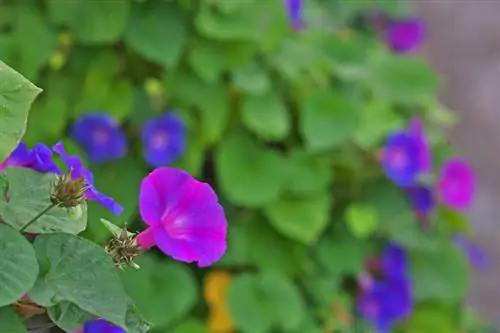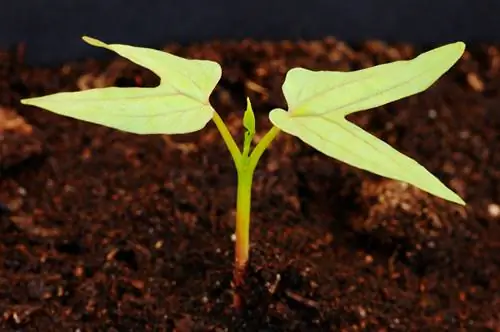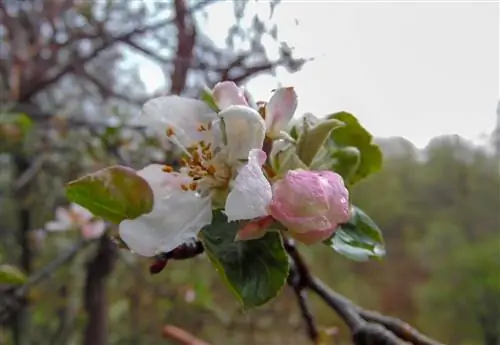- Author admin [email protected].
- Public 2023-12-25 17:45.
- Last modified 2025-01-23 11:20.
With furious bell-shaped flowers in its luggage, the morning glory climbs trellises, fences, facades and carports. As if the annual summer flower were aware of its limited time, it shows breathtaking growth. The following answers to frequently asked questions explain why the Mexican flower beauty still appears grateful and easy to care for.

How do I properly care for a morning glory?
The morning glory is an easy-care, annual summer flower that impresses with colorful bell-shaped flowers and rapid growth. It prefers full sun, protected locations, nutrient-rich and well-drained soil and regular watering and fertilization.
Planting morning glories correctly
The summer flower festival starts in mid-May. Prepare loose, humus-rich soil for the morning glory in a full sun, protected location. Dig spacious planting holes at a distance of 30-50 cm. Optimize the excavation with compost, horn shavings and a little sand. Meanwhile, place the still potted root balls in lime-free water. After this preparation, it continues like this:
- Place a potted morning glory in the middle of each pit
- Fill the planting hole with the substrate just below the first pair of leaves
- Water with soft water and mulch with leaves or grass clippings
So that the delicate tendrils on the climbing aid take the desired path, attach them to the lower struts with great sensitivity.read more
Care tips
It doesn't take much effort to care for a morning glory. The tropical summer plant produces its magnificent flowers and leaves when it receives these gardening attentions in a full sun, protected location:
- If the surface of the earth dries, the morning glory is watered
- Administer liquid fertilizer for flowering plants every 8-10 days from May to October
- Alternatively, ripen compost and horn shavings lightly rake in and water every 14 days
- Additionally sprinkle the soil with nitrogen-rich nettle manure
- Consistently clean out the withered flowers for abundant rebloom
Once the enchanting Ipomoea has finished its summer visit to the garden, cut the plant close to the ground or dig up the root ball.read more
Which location is suitable?
The brilliant flowers require a location in full sun, warm and sheltered from the wind. If the morning glory functions as a facade greenery, a place under the protection of a roof overhang is advantageous. The exotic climbing artist proves to be undemanding when it comes to the nature of the ground. It thrives in any normal garden soil that is well-drained and not too acidic.read more
What soil does the plant need?
The morning glory prefers fresh, moist, loamy-sandy soil, rich in nutrients and well-drained. The summer flower is satisfied with a neutral soil acidity value. The exotic beauty adapts easily to a slightly acidic pH value or a tendency towards alkaline.
When is flowering time?
With a lavish abundance of flowers from June to October, the morning glory lives up to its name. Cut out the wilted flowers every few days because there are already new buds underneath. If you notice leaves that shade buds and flowers, these will also be removed.
Cut morning glories correctly
Under your loving care, a morning glory sometimes takes its floral task too literally and goes beyond the dimensions. Feel free to trim the morning glories into shape in the middle of the season. The flowers and leaves are not damaged. We also recommend cleaning out wilted bell flowers regularly to ensure colorful re-blooming.
Watering morning glories
The sunnier the weather, the more extensively the morning glory evaporates moisture from its enormous volume of foliage. Therefore, water the plant regularly as soon as the soil has dried on the surface. On warm summer days, this may be mandatory in the early morning and again in the evening. However, too much of a good thing leads to waterlogging and triggers root rot. Therefore, slowly pour the water from the can spout onto the root ball and stop as soon as no more moisture is absorbed.
Fertilize morning glories properly
Don't let your morning glory starve, because it needs plenty of energy for rapid growth and the impressive flowers and leaves. From May until the end of the flowering period, fertilize every 8-10 days with a liquid fertilizer for flowering plants. Alternatively, you can work ripe compost superficially into the soil every 14 days and sprinkle the soil with nettle manure every now and then.
Propagate morning glories
Leave a few flowers on the morning glory in summer so that the spherical capsule fruits thrive. You collect these in autumn to dry the seeds inside and store them in a cool place until next spring. Please consider the toxic content when carrying out this work and wear protective gloves. From March sow the seeds like this:
- Soak the seeds overnight in water or chamomile tea
- Fill a seed tray with peat sand (€6.00 on Amazon) and moisten it
- Scatter the still-moist seeds and sift them thinly with substrate or sand
- Set up in a heated indoor greenhouse at 20-25 degrees Celsius
In a partially shaded location, the seeds germinate within 10-21 days. As you continue, transplant the strongest seedlings into 9 cm pots if they have at least 2 pairs of leaves. Until mid-May, care for the young plants on the bright windowsill at 18-20 degrees. In mid/late April, a little diluted liquid fertilizer every 8 days will get the seedlings going.
Morning glories in a pot
In the pot with integrated trellis or the flower box with built-in trellis, the morning glory bathes the balcony in a summery sea of flowers. As a substrate, choose a good compost-based potting soil enriched with sand, lava granules or perlite. A water-bearing layer of clay shards on the bottom of the pot prevents waterlogging. Plant an Ipomoea in a slight slant to aid climbing and water generously. Maintain a constant water supply supplemented with weekly applications of liquid fertilizer. Clean out the withered flowers every 1-2 days and otherwise enjoy the furious flower festival.
Is morning glory poisonous?
The spherical fruits of a morning glory are full of poisonous seeds. Consuming even small amounts can lead to significant symptoms of poisoning, especially if the seeds end up in a child's stomach. So that children and pets are not tempted to snack on it, we recommend using alternative climbing plants in the family garden.read more
Beautiful varieties
- Heavenly Blue: Vigorous morning glory that strives towards the sky with light blue flowers on the facade and trellis
- Flying Saucers: Colorful Ipomoea that stands out with blue and white funnel flowers
- Sunrise Serenade: Summer feast for the eyes with double, white-pink flowers and rapid growth rate
- Cameo Elegance: Morning glory impresses with pink-red flowers, white throat and green-white variegated leaves
- Morning Star: Breathtakingly beautiful with crimson flowers, white center and dense foliage






